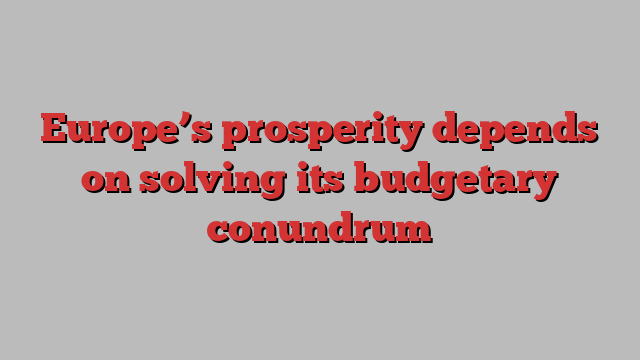
Unlock the Editor’s Digest for free
Roula Khalaf, Editor of the FT, selects her favourite stories in this weekly newsletter.
The writer is president of the Eurogroup
Europe is at a budgetary inflection point. We need to reduce deficits and rebuild a stronger financial safety net while facing multiple short- and long-term spending and investment demands, including the green and digital transitions, defence, security and ageing. To do this we have to strike the delicate balance between sustainable public finances, strong investment and solid economic growth. In short, Europe’s prosperity depends on solving a budgetary trilemma.
Despite some unexpected external shocks in recent years, the euro area economy has remained exceptionally resilient. The best testimony to this is the robust labour market performance, with jobless numbers at historic low levels. However, the budgetary environment has become more challenging.
Across the euro area, borrowing costs have risen by close to 300 basis points since the end of 2021 and government spending, as a share of national output, is now significantly ahead of pre-pandemic levels. Budget deficits in the euro area averaged 3.6 per cent of GDP last year, with public debt at just under 90 per cent. These numbers are somewhat higher than estimated last autumn. In part this reflects the loss in growth momentum in the latter part of 2023 but also higher levels of borrowing in some larger countries. Seven countries have recently been put forward for an excessive deficit procedure.
At the same time, Europe faces a very substantial and increasing investment gap that could conservatively be placed at €1tn per annum once climate, digital and defence needs are added together. Thinking further ahead, with an ageing population and an enlarged EU, these numbers will only get bigger.
Economic policy has normalised over the past few years but we need to step up how we manage our public finances. While inflation rates have fallen across the euro area, progress in reducing and narrowing borrowing levels is taking longer. As countries prepare their budgetary plans for 2025 and we go back to normal budgetary surveillance, pursuing sound public finances and debt sustainability remain key. That is why it is imperative that countries’ medium-term plans, which are integral to our new budget rules, begin on a strong and credible footing. Success rests on having a high level of political buy-in within countries alongside realistic and enforceable budgetary paths.
But we also need to address our key challenge, which is about improving growth and delivering higher living standards for our citizens. Europe is falling short in terms of its growth potential. It is clear that we need to continue with structural reforms and expand investment. There are important budgetary constraints as we pursue policies to put our public finances on a more sustainable footing.
Precisely for that reason, we have to make the best use of European instruments such as NextGenerationEU. NGEU has been an unprecedented joint European response meant to preserve and increase public investment, to put our economies on a stronger, more sustainable and inclusive growth path. We are halfway through implementation and we must ensure that the best use is made of the remaining time. Any discussion on future common borrowing can only be plausible if we have made NGEU a success.
In parallel, we need to make progress on the capital markets union. Results will only be tangible in the medium term but this is not an excuse for delay. It is clear that we cannot meet our long-term investment needs through the public purse alone. A deeper and more integrated capital market in Europe is required. We now have an important ingredient for progress that we did not in the past — political will. We should make the best use of it. European finance ministers have committed to work on moving this forward. Debates on what can be done at national level are picking up in different countries. As the new European Commission comes into office, we look forward to a new agenda focused on delivery and implementation.
And while it may seem that we are facing a budgetary trilemma of sorts, I remain convinced that there is a path forward. Tangible and timely progress on the capital markets union is key to resolving this. It will not only ensure that we can keep up the pace of investment, but it will also facilitate a return to lower levels of borrowing. A real shift in growth levels across the EU will depend on progress on these fronts.
Ultimately, embracing both economic prudence and investment for the future is not a choice between caution and ambition. It is a strategy for resilience and growth in an ever-evolving world.